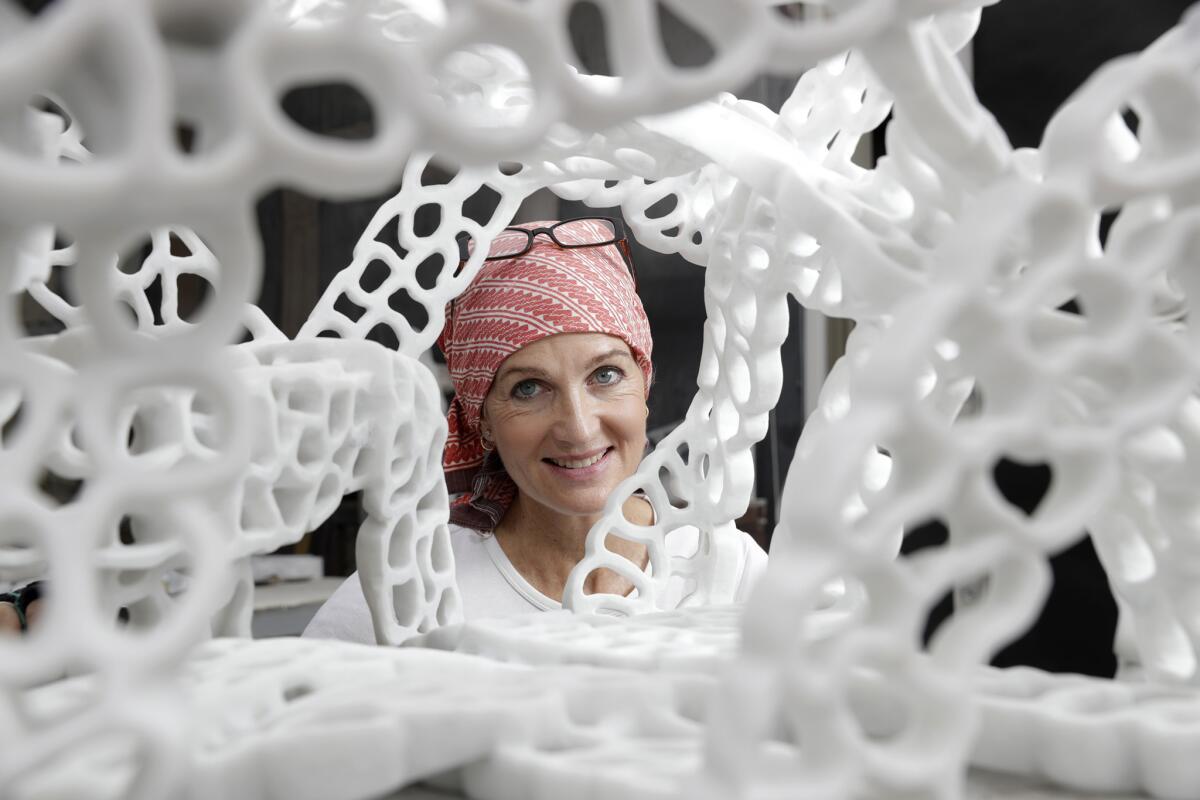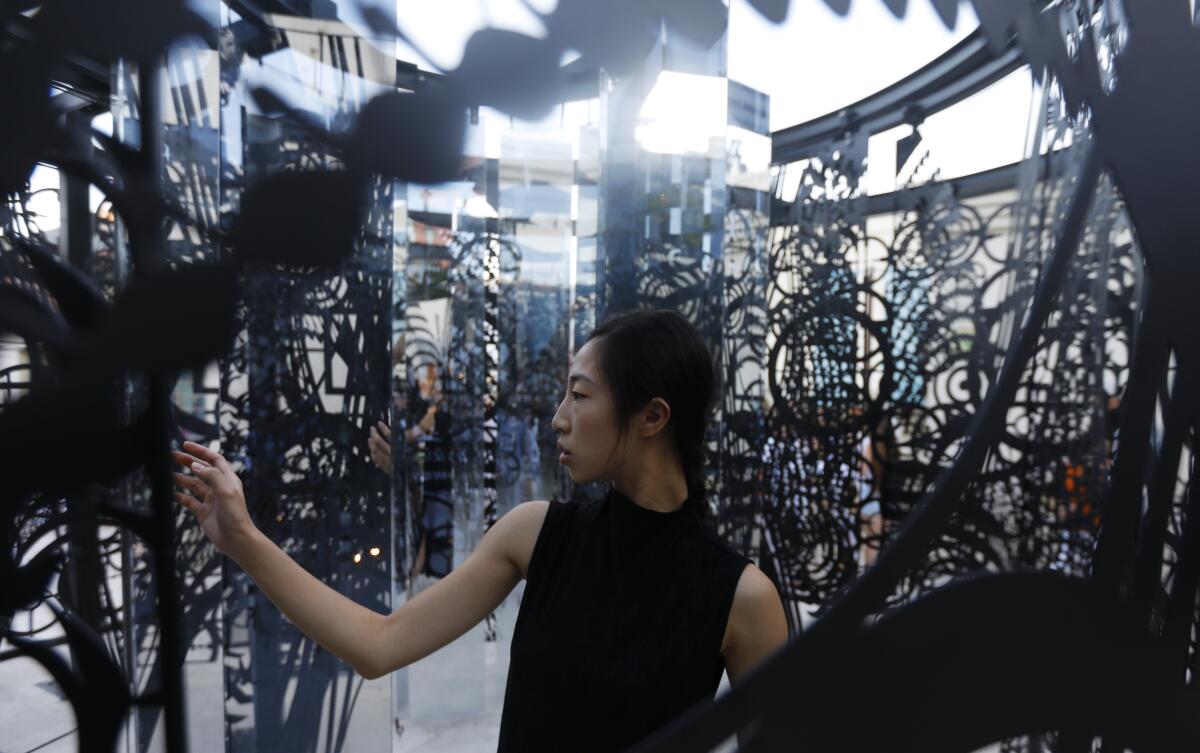Endangered birds at the ‘Tipping Point’: Artist Elizabeth Turk’s latest on Catalina Island
- Share via
Even as artist Elizabeth Turk was launching “Shoreline Project,” the massive outdoor work she presented last November with Laguna Art Museum, she was thinking about birds.
She’d brought 1,000 volunteers to the beach at twilight, outfitted with specially designed, illuminated umbrellas featuring Turk’s seashell X-ray mandala design on top. More than 3,000 onlookers gathered along the coast and on the cliffs overlooking the ocean to watch as Turk’s creation — more than a year in the making — become a living, breathing artwork. Drones equipped with cameras soared overhead, offering a bird’s-eye view of the experience. Yet as “Shoreline” started to wind down, Turk’s mind was already drifting to her next project: “Tipping Point,” about extinct and endangered birds and their relationship to humans.
“I’ve been thinking about all of these ideas for a long time — before ‘Shoreline.’ I wanted to start a conversation about them,” Turk says on a recent morning in her studio in Santa Ana. “I just had no idea that it would evolve into this.”
Her preoccupation with birds evolved into ‘“Tipping Point,” the multi-pronged art installation she unveiled in April at Catalina Island Museum, with the official opening earlier this month. It’s on view through March of next year.
Turk, a 2010 MacArthur “genius grant” fellow, is perhaps best known for her delicate marble sculptures carved into intricate ribbon patterns. While “Shoreline” has been Turk’s largest project to date, “Tipping Point” is more intimate in scale but still lofty in ambition.
The largest part, “Migration Patterns,” is a circular, cage-like structure, 20 feet in diameter, made of 8-foot-by-4-foot black metal screens placed side by side on casters to form three cylindrical rings. The pattern on the outer ring consists of overlapping, laser-cut concentric circles that loosely resemble “targets.” The middle ring is designed with cutouts of migrating birds in flight, while the innermost ring is made of 8-foot-by-2-foot reflective Plexiglas panels facing outward. Visitors can walk through and move panels, exploring the maze-like cage while working their way to the center, which is designed to let people see outward but makes them invisible to those looking into the structure — a metaphor for extinction.
“The targets are a really beautiful, decorative pattern. But when you start think about the targets, you see how the shadows fall into the patterns of the birds, having their sights set on the birds,” Turk says, describing the captivating but ominous design.

Inside Elizabeth Turk’s airy, sunlit studio overlooking the back bay in Newport Beach, the artist is hard at work on her latest creation, “The Shoreline Project.”
Museum visitors then enter a narrow passageway, where motion-activated sensors trigger recordings of bald eagles, marsh wrens, brown pelicans and parakeets, lead them to “Echoes of Extinction” — about a dozen vertical works that Turk calls “sound sculptures.” Sculpted from aluminum and other materials, the sculptures were inspired by the soundwave patterns from recordings of extinct or endangered birds, cataloged by the Cornell University Lab of Ornithology in Ithaca, N.Y. Near each sculpture is a QR code that visitors can scan to connect to the Cornell Lab to hear the actual bird sounds.
“We created the bald eagle and the brown pelican because both of them are endangered to Catalina. They’re special birds on Catalina,” says Turk, who also added whale and porpoise sculptures for this exhibition. “We experimented with wood and recycled plastics and the idea of trying to create a ‘sound forest,’ so you could walk in and around the different shapes.”
At the exhibition’s official opening on July 13, another component of “Tipping Point” — “Are We Creating a Silence?” — was added. After a brief introduction by Turk and museum director Julie Perlin Lee, the Orange Coast College Chamber Singers performed Olivier Messiaen’s “O Sacrum Convivium,” and a trio of dancers from Assembly Dance company moved to music by Los Angeles composer Michael Mortilla. Museum guests were given LED candles and invited to create light drawings that would be captured by time-lapse cameras and drones, edited, then put on display. At the end of the night, the nearly 200 museum visitors were split into groups and asked to turn off their candles, group by group, as a symbol, Turk says, “of our own extinction.”

Lee first approached Turk about an art installation in 2016, shortly after she was named executive director of the Catalina museum, which had just moved to a new building. The two women met more than a decade ago when they were both living at the Grand Central Art Center in Santa Ana and had crossed paths over the years, always hoping to collaborate. “Tipping Point” became their opportunity.
“The idea was really loose. I’m not sure how deeply she had gone in her mind, thinking about the topic of extinction,” Lee says. “The original presentation was just thinking about how to do something that talks about or looks at birds and the state of birds.”
Even though the project wasn’t fully formed, Lee felt the idea alone was ideal for the island community. “We have a long history with birds, just in our natural habitat, but also, William Wrigley Jr., who bought the island 100 years ago, and supported creating, at the time, the largest aviary of birds. There was a large bird-breeding program on the island for years.”
After “Shoreline Project” was completed, Turk launched what she calls “Think Lab Live,” in which she worked with Tyler Stallings, director of the Frank M. Doyle Arts Pavilion at Orange Coast College, to create a space to share initial concepts for the project. Members of the community were invited to help shape the work. She had launched a similar think lab for “Shoreline.”

“So often, there’s an elitism around art, and it’s really just creativity and imagination. Everybody has that,” Turk says. “We wanted a doorway into the art piece that expanded the number of people who could feel confident and realize that art is something that is for them. I thought, like a seashell, everybody has a relationship with a bird.”
On the walls and on the wood pallets on the floor of Turk’s Santa Ana studio are dozens of early models and test designs for various elements of “Tipping Point”: miniature cylindrical cages in a variety of metals; a reflective panel featuring cutouts of birds; assorted tubes wrapped with images of birds perched on wires in a pattern resembling a musical score; a metal sheet with delicate cutouts of extinct macaws and parrots. In another area of the studio, the wall is papered with several geometric sketches that, it turns out, are Turk’s interpretations of Southern California freeways that would later be incorporated into the cage panels.
“I was looking at things that connect us — what brings us together — for another project. I went around to all the intersections in and around L.A., and I took pictures of the GPS and started playing with them and creating a pattern around them,” Turk says. “I stole it from the other project — it made sense because those intersections are where we come together. They are migration patterns.”
For Turk, “Tipping Point” is just the beginning of an ongoing project that will continue to be refined after the exhibition at Catalina Island Museum is over. She’s hoping to expand the size of the cage and find a venue, such as the Marciano Foundation, where viewers can look down at the installation as visitors navigate the maze cage.
“This has been a crazy, wonderful experience,” Turk said at the end of the night on Saturday. “This will be part of our collective memory. We want to get everyone to think about extinction and our part in it. This is just a start.”
More to Read
The biggest entertainment stories
Get our big stories about Hollywood, film, television, music, arts, culture and more right in your inbox as soon as they publish.
You may occasionally receive promotional content from the Los Angeles Times.











